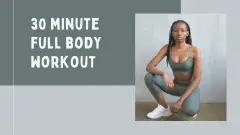Kickstart your New Year fitness with this 30 day weight loss challenge. It’s a combination of walking, running and an indoor circuit to burn calories and tone up your legs. The intensity increases throughout the 30 days, finishing with a 30 minute interval walk, 25 minute run and a 60 reps/60 seconds circuit.
About the New Year Weight loss challenge
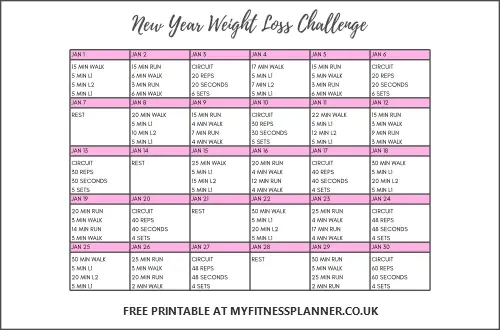
Please read these general exercise guidelines before you start. This is a beginner/intermediate level workout that includes running and other high impact exercises. If you have joint problems or you are very overweight, you should avoid high impact exercise – try walking 3 miles a day or this treadmill weight loss program.
The walks and runs have warm ups included. You need to do a warm up before the circuit though – see a suitable warm up here.
What you need to do the challenge
Shoes – for running and the circuit you’ll need training shoes that absorb impact. You can wear these for the walking too, or any flat, well-fitting shoes.
Clothing – suitable exercise clothing. All 3 workouts are likely to make you warm, so you should be able to remove layers.
Timer – you’ll need some sort of timer for all 3 workouts. Either use a fitness watch, a phone app or a stopwatch.
Water bottle – you should take frequent sips of water while doing your workouts.
Your walking/running route
If you’re walking and running outdoors, the easiest way to make sure you’re routes are the right length is to walk or run for half the time and then turn around and go back. Planning a circular route or a “from A to B” route would be time consuming, due to the distances changing throughout the challenge.
Walking and running indoors
You may find walking and running indoors more convenient. Both indoor and outdoor running have their own advantages.
Advantages of the treadmill
With a treadmill it’s easy to set your walking speed and keep your speed continuous. You don’t need to worry about route planning and, if you want the challenge of an uphill walk then it’s easy to increase the gradient. You also aren’t affected by bad weather.
Advantages of walking outside
On the other hand, the predictable conditions of the treadmill make it less of an all-over body challenge because you don’t have to cope with uneven surfaces and changes in direction. Walking in the street or park is also free of course, whereas gym membership or buying a home treadmill can be expensive. You’ll get the benefit of fresh outdoor air, which is good for mental as well as physical health.
Buying a treadmill for home use
Now that folding treadmills are widely available, having a home treadmill doesn’t mean you need a dedicated workout space. You can fold your treadmill up and store it out of the way between walks. If you’re thinking of buying a home treadmill, here are some points you should consider:
- Are you likely to run on it? If so, you should avoid very lightweight models. Also, a cushioned running/walking deck will help to absorb impact.
- Dimensions: there’s a slight variation in dimensions between models. If you’re tall, you might prefer a longer walking/running deck to allow for a longer stride. Obviously, the treadmill needs to fit in your chosen storage place when it is folded away.
- What sort of a console do you want? Is it important to you to have a multi-feature console with a choice of preset programs, or will you be happy with something simple that just lets you set speed and incline? Extra functions add to the cost of the treadmill, so think about whether you really need them.
- What is the incline range? Some treadmills only have a limited incline range. Models that offer up to 12% give you more options to vary your workouts and to challenge yourself more as your fitness improves.
- Maximum speed – if you run fast, or plan to do sprint intervals, you should bear the maximum speed in mind. For walking, or average speed running, any treadmill will be fine.
Walking speeds
The walks are divided into level 1 and level 2 speeds:
- Level 1: a normal walking pace
- Level 2: a bit faster than normal walking speed, enough to make you breathe a bit heavier and feel warmer
Each walk is split into intervals at level 1 and level 2 – the chart below tells you how many minutes to do at each.
Running pace
There’s no set speed for the running. Running is a high intensity activity and as long as you’re running that’s good enough, you’ll be burning calories. All the runs have a walking warm up and cool down – as you work through the challenge the warm up and cool down become shorter and the running times longer.
The circuit
There are 6 exercises in the circuit – 3 for leg strength and 3 for cardio. The challenge chart shows how many repetitions of the strength exercises to do, how long in seconds to do the cardio exercises for and how many sets to do. (A “set” is one round of each exercise. So in week 1 for example you do each exercise for 20 reps/20 seconds, then once you’ve done them all start again and repeat another 5 times.) The number of sets is higher at the beginning, because the exercise reps/time is shorter. As your stamina increases, the exercise times become longer and the number of sets goes down.
Exercise instructions
#1 Squat
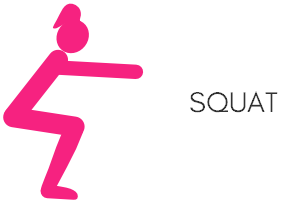
- Have your feet a little more than hip distance apart, parallel or slightly turned out.
- Bend at your knees and hips as you lower into squat position. Aim to get your thighs parallel with the floor and then come up again.
- Straighten up gently, don’t jerk your knees backwards.
#2 Side leap
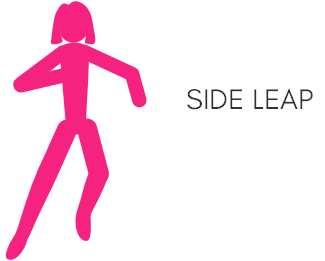
- Start by standing with your feet close together.
- Raise your right knee, then jump sideways to the right, leading with your right leg.
- Follow through with your left leg, bringing your left foot close to your right.
- Now lift your left knee and repeat to the left.
#3 Lunge
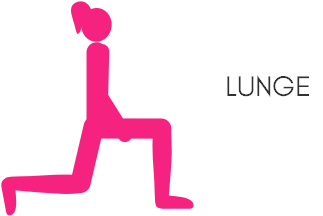
- Stand with your feet about hip distance apart
- Take one leg out behind you and touch your toes to the floor. Make sure you keep your feet hip width apart.
- Now bend at both knees, so that you lower your body towards the floor. At the end of the movement, your thighs should be parallel with the floor, your front knee should be bent to 90º and in line with your ankle, your back knee should be just above the floor.
- Bring your foot back to the starting position and repeat with the other leg.
#4 Knee lift

- Raise your arms overhead.
- Lower your arms as you lift one knee.
- Raise your arms as you lower the knee.
- Lower your arms as you lift the other knee.
# 5 Side squat
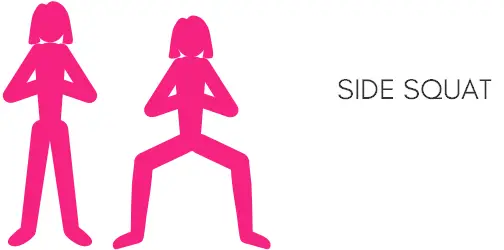
- Stand straight with your feet about hip distance.
- Take a step to the side and bend your knees so that you come into a wide squat position.
- Come back to the starting position.
- Repeat, this time squatting to the other side.
# 6 Jog
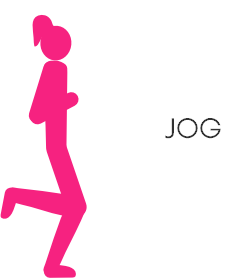
- Keep your shoulders back and abdominal muscles engaged.
- Focus on jogging in a controlled way, don’t land heavily on your feet.
New year weight loss challenge chart
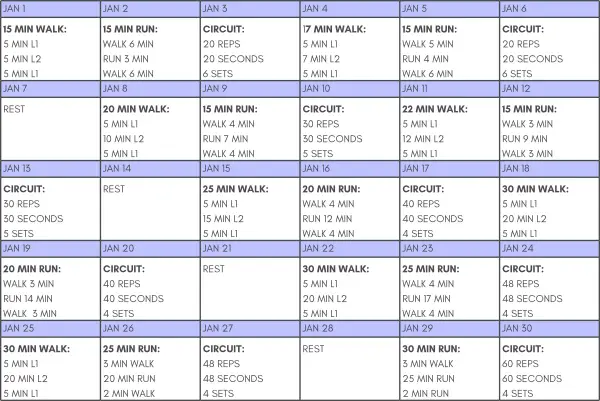
Get a copy of the challenge printable
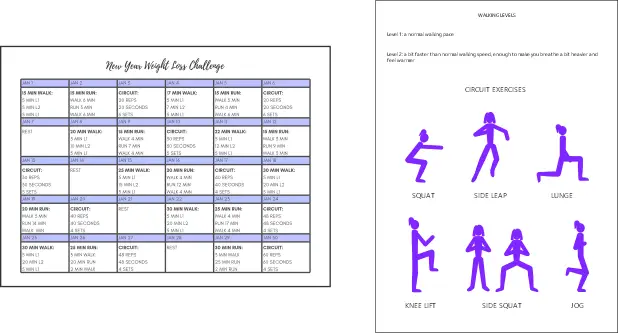
Sign up for My Fitness Planner updates and get the free printable download link e-mailed to you:
After you sign up, you’ll get 2 e-mails, one will have a link to your printable download and the other will be a welcome e-mail.
If the e-mails haven’t turned up within a few minutes, please check your junk folder, as some service providers have very strict filters.

